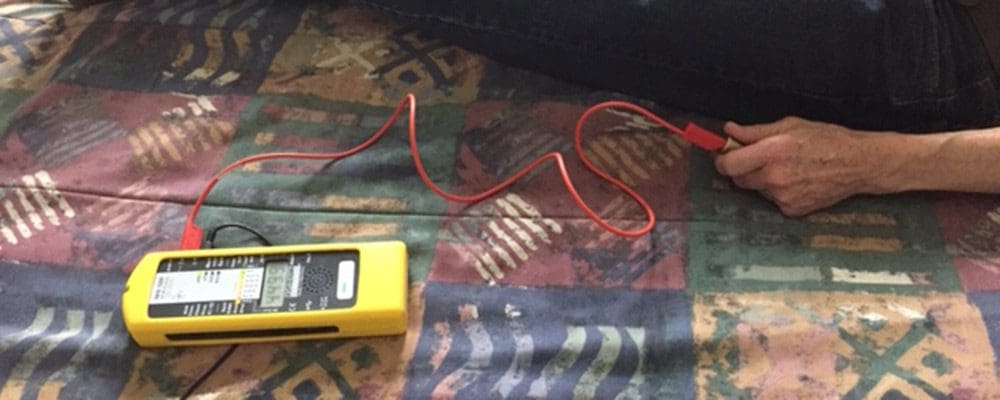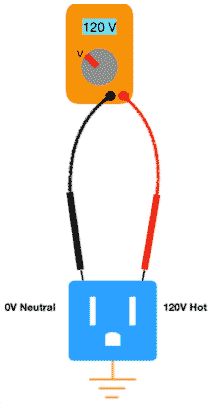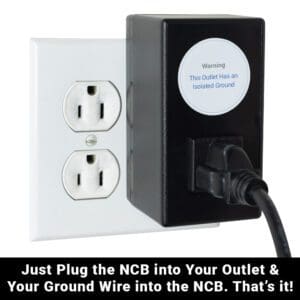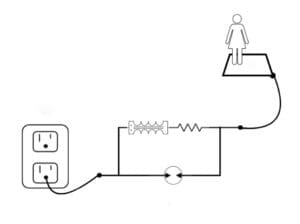Here at SYB, we get a lot of questions about body voltage– what it is, and how to measure it. That’s what we’re going to learn in this post.
When measuring EMF, there are a lot of relevant terms you may come across. Words like ‘radio frequency’ (RF), ‘microwatts’ (uW), ‘milligauss’ (mG) and ‘alternating current’ (AC).
‘Body voltage'(BV) is another of these, and it directly relates to one of the four major EMFs – electric fieldsDefinition and Nature of Electric Fields Electric fields are a fundamental aspect of electromagnetic fields, created by electric charges, either stationary or moving. These fields represent the force that electric... (sometimes called E-fields). Measuring body voltage is one way to try and measure how much electric fieldIn the context of electromagnetic fields (EMF), the term "field" refers to a region in space where electric and magnetic forces are exerted. An electromagnetic field is generated by electrically... EMF radiation"Radiation" in the context of Electromagnetic Fields (EMF) refers to the process by which energy is emitted and transmitted through space or a material medium in the form of electromagnetic... your body is exposed to.
E-fields are the least appreciated and discussed of these fields, but just as important as the others in fact the others are made up of E-fields.
So let’s learn how to test electric fields and what the difference is between ‘floating’ measurements and a ‘grounded reference’ body voltage test (floating is a radiated emission test and conducted is a grounded reference, making contact or touch).
If you’re serious about reducing your EMFs and want to experience better sleep, more stable moods, and better health in general, then get out your pen and paper and get ready to take some notes!

Want to Slash Your EMF Health Risks?
Want to Slash Your EMF Health Risks?
Good! Learn the one small change you should make right now.
What Are Electric Fields
Let’s start by explaining what electric fields are. By the name, you can see that electric fields come from electricity.
Anywhere there is anything electrically charged or energized in the universe, you will find electric fields.
They are the foundational energies expressed by positive charges, which emanate fields outwards and negative charges which pull inwards.
This forms the web of our universe, a polarity between two forces, positive and negative.
The push and pull between positive and negative forces are required for all chemical and electrical actions. Without this push or pull, there wouldn’t be any attraction, or repulsion, no electrical current"Electrical current" refers to the flow of electric charges (like electrons) through a conductor, such as a wire. It's similar to how water flows through a pipe. In electrical systems,..., no chemical reactions or exchange of energy"Energy" is a fundamental concept in physics, often described as the ability to do work or cause change. In everyday terms, it's what is needed to move things, heat them....
An atom’s proton is positively charged and its electron (one or more) orbiting around it is negatively charged.
There is an electric field holding or attracting them together. Opposites attract. Then there are larger areas that are more positively charged (less electrons) and areas that are more negatively charged (more electrons).
Then, current is the manifestation of electrons or charges moving from one place to another. The universe eternally seeks balance and a high pressure area will seek to flow to a lower pressure area.
Of course, there are naturally occurring E-fields in the body that are DC, direct current"Direct Current" (DC) is a type of electrical current where the electric charge flows consistently in one direction. It's like water flowing steadily in a straight line through a hose...., traveling in one direction. Your body has nerves which communicate via electrical currents based upon this relationship. This is why your heart can be ‘shocked’ back into a normal rhythm when it develops an irregular heartbeat.
For our purposes here, we are first concerned about home wiring E-fields that are AC, ‘alternating current’ (pulsing 60 times a second) from the power"Power" in a scientific context refers to the rate at which work is done or energy is transferred. In simpler terms, it's how fast something is using energy. For example,... grid, as they have been shown to cause negative health effects.
Primary Sources of E-Fields
Some of the main sources of E-fields that we are exposed to come from:
- Wires in our walls
- Cars
- Computers
- TV’s
- Power cords
- Phone chargers
- Power lines
- Household appliances
- Lamps
- …and more or less any devices that runs on electricity.
How do Electric Fields Affect Our Bodies?
There are several ways that EMFs affect the human body. We have discussed this at length in several other posts.
See our extensive articles on the subject here.
As a quick review, all of these electromagnetic fields can effect the body’s oxidative stress pathways.
As I previously explained in the EMF’s and Nutrition post; EMF radiation impacts our DNA, our nervous system, our brains, and the associated illnesses from long-term exposure.
One of the primary ways they impact the body is through the activation of the cells’ voltage-gated calcium channels (VGCC’s).
EMFs Affect VGCCs
Specific cells in your body have proteins on their outer membrane that open and close to let in certain nutrients.
For instance, the VGCCs are responsible for controlling how much calcium is let into the cell. The heart has sodium channels and there are others as well.
Membranes sense the voltage difference (electrical pressure, = more or less electrons) between the inside and outside of the cell.
An excessive difference in charge will force these gates to open and drive too much calcium into the cell. This negatively impacts or natural pH levels, cellular waste removal, mitochondrial function, and can even effect genetic material, interfering with cell death.
To say the least, too much calcium inside the cell can cause excessive levels of oxidative stress. See the work of Dr. Martin Pall for more on this topic.
For E-fields and AC specifically, we know they can negatively influence circadian rhythm, interrupt appropriate melatonin release, and research has also correlated an increased risk of cancer to E-field exposure.
Anecdotally, people exposed to even low levels of AC electric fields have reported numbness and tingling, tinnitus, sleep disturbances, nerve pain, cognitive impairment, anxiety, depression and much more.
While magnetic fieldsDefinition and Nature of Magnetic Fields Magnetic fields are a fundamental aspect of electromagnetic fields, produced by moving electric charges (electric currents). The strength of a magnetic field is measured..., radio frequencyRadio Frequency (or RF), a subset of EMF, encompasses electromagnetic wave frequencies ranging from about 3 kilohertz (kHz) to 300 gigahertz (GHz). These frequencies are extensively used in modern wireless... and dirty electricityDirty Electricity, also known as electrical pollution, refers to the presence of irregularities or distortions in the normal electrical current within a wiring system. These distortions, which deviate from the... have all gotten a lot more attention over the years, it is clear that AC generated E-fields are just as hazardous and require just as much attention to measure and mitigate.
How Do You Measure Electric Fields?
As I alluded to above, there are different ways to measure E-fields, either floating or contact.
The best way is with an NFA 1000, ‘floating’ (not requiring a grounded reference point) in 3 axis mode, sensing the AC electric fields in a space.
But the NFA is very expensive so many resort to using a body voltage meter, or multimeter.
When you measure the E-field push/pull in your environment, what you’re actually measuring is the imbalance of energy, the ‘potential’ for current between two different objects.
Potential means, if current were to flow, how much? We don’t know. There is potential for current and we know the force, the voltage.
But there is something else missing to actually know how much current will eventually flow and that is the resistance"Resistance" is a fundamental concept in the field of electricity and electronics, central to understanding how electric circuits operate. It refers to the opposition that a material or a device..., what will impede the flow of electrons or movement of charges.
So voltage is the potential for how much current could flow, but we don’t know.
A real-world E-field example – if you have a lamp plugged in on your bedside table, that cord on the lamp will be ‘hot’ and will emanate an E-field several feet in all directions whether the lamp is turned on or not.
If the lamp switch at the bulb is off, the line is still energized all the way to the lamp switch. There is pressure, a voltage, so an E-field.
Another way to experience this is using a water hose with a squeeze nozzle attached. If you turn on the faucet, the water will flow to the nozzle and then stop.
The water inside that hose is not moving, but it creates pressure on the hose. That pressure is the voltage. Voltage and electric fields go together.
Current and magnetic fields go together. No water flow, no current, no magnetic field, but the voltage/E-field remains if there is pressure.
This is the same thing the electricity is doing with your lamp’s wire, and all the wires running through your walls. Even if no lights or appliances are turned on, the wire has ‘potential’ or electrical ‘pressure.’
If you were to touch a live uninsulated wire with bare skin, you would get shocked because you become the hose and that pressure is trying to go through you.
So when you’re measuring the electric fields in your home, you are essentially measuring this pressure. But remember the separate variable, the resistance of the hose (small or big) that will determine how much water will flow, the current, at that flow creates a magnetic field.
We measure electric field potential (the difference between two points and its potential for current) with voltage.
Using an EMF Meter
An electric field meter or voltmeter measures the field strength of alternating electric fields in volts (V) making contact with a grounded reference, and in volts per meter"Volts per meter" (V/m) is a unit of measurement in the International System of Units (SI) that quantifies the strength of an electric field. This unit is particularly relevant in... (V/m) with a floating measurement of what’s in the air.
Let’s say your NFA 1000 measures 1 V/m. This means there is a difference of one voltThe term "Volt," named after the Italian physicist Alessandro Volta, is a unit of electric potential, electric potential difference (voltage), and electromotive force (EMF) in the International System of Units... in the air between two objects separated by one meter.
The highest pressure zone is one meter away from the lowest pressure zone and the difference between them is 1 volt.
E-fields will find every route or path to crawl or jump from areas of higher pressure to lower pressure. Positive seeks and reaches out to negative charges and vice versa seeking balance.
If your body is in this electrified environment, these exterior electric fields will flow on or through you and they can alter (push/pull) the charges inside your body.
The number one rule of current flow is it requires a circuit. The electrons start at the generator source (power station, transformer, etc.) and they must return to that source.
AC returns to its source, not to groundIn the context of electricity, "ground" or "earthing" refers to a reference point in an electrical circuit from which voltages are measured, a common return path for electric current, or.... It can use the ground to return to its source. This out and back in a circle is the circuit like a bicycle chain of unbroken links pulling on each other.
There will be E-fields along this path pushing to find all the routes and pathways to return home. When it finds a path and current flows, there is an added magnetic field.
When you’re using a typical body voltage meter (multimeter) to test for E-fields, the measurements can be influenced by the instruments themselves, the probes, test leads, and even your own body touching the floor.
The test leads, if they are plugged into the ground prong of an outlet, can become a part of this circuit. This will be a path for current and electric fields will glob, attach onto this pathway.
This can cause the measurement of the space to be altered.
Floating Measurement
To remedy this, some Building Biologists prefer to measure electric fields with a ‘floating’ measurement, no contact, no grounded references, so the E-field in the room isn’t altered. The opposite of this is the grounded method.
A grounded reference body voltage measurement is a direct contact measurement and could be an indication of the electric field pressure on your body.
Some prefer this way as they feel it more accurately represents the impact on the body. We need to discuss it since it is so easy to do, every body does it and the meters are cheap to purchase.
What is the Protocol for Measuring Body Voltage?
As opposed to just measuring the electric field is in the air, the body voltage measurement shows (by touching, making contact) the difference of the voltage found on the skin of the body (hand holding the red lead) and comparing it with a reference point (black lead).
Where the black lead plugs into is the big problem. Is it to a stake 50 feet away out in the yard or in an outlet grounding conductorThe term "conductor," in the context of electromagnetic radiation, refers to materials or substances that allow for the efficient passage of electromagnetic energy, including both electric currents and electromagnetic fields.... prong? More on that soon.
To measure body voltage you will need a body voltage meter– such as this one from Safe Living Technologies– or a voltmeter that you can hook up with a body voltage probe (copper bar).
You will have two probes that get plugged into the meter. One end (black lead) can be attached to a ground stake in the yard in moist soil (preferred).
If you can’t reach the earth, then you will attach the probe to a ground plug in a grounded outlet inside the home or building (this connects to a ground wire that is connected to the earth back at the main electrical panel and eventually to the power grid transformer, the source).
The other end probe (red lead) is attached to a hand probe, usually made of brass or other conductive metal.
The person being evaluated holds on to the probe, then the meter measures the voltage between the person and the power grid.
What? Yes, the earth around the home is being energized by the grid’s return current, which is grounded at the main service called the Service Neutral, a grounded conductor, and one at the transformer which is connected to the primary return conductor.
The multi-grounded neutral grid system uses the earth as a path for return current so it is very difficult to measure anything NOT associated or effected by the power grid.
The grounding conductor in an outlet is at a similar voltage as to the primary side of the transformer return current.
So we are testing the pressure on our body compared to the power grid’s grounded return current path. Hmmm.
Plug in and hold the bar, that’s really all there is to it! It’s quite simple to do and interesting to show how your body is being impacted in the areas you spend the most amount of time.
Limitations of Measuring Body Voltage
It’s important to understand that testing body voltage serves a certain purpose in identifying the success (or not) of some mitigation strategies.
However, as EMF professional Andrew McAfee has so expertly demonstrated in his work with EHS people, it’s not the voltage per se that is causing us so much harm, it’s actually the current. And voltage, between the grid and the body really shouldn’t be the comparison points. We don’t want the grid connected to us.
For this reason, McAfee is a strong proponent for measuring current, instead of voltage, to more accurately identify the harm that we are being exposed to.
The reasons for this are highly complex, but I will attempt to summarize the key points of McAfee’s findings to help you understand.
As the National Institutes of Health explain: “…the voltage … does not provide any direct information with respect to the amount of current traveling through [the body] intracellular versus extracellular volumes …”
As we have already learned, “voltage” is the electric pressure difference between two points. But– and this is what’s important– numerous studies have proven it’s current that is causing the biological harm, not the voltage. Once the current starts, the skin impedance changes. Without current flowing we really don’t know the real threat levels.
So while BV testing can provide us with information about our environment, McAfee argues it’s the contact currentDefinition and Basic Concept Contact current refers to the electrical current that flows through a person’s body when they come into physical contact with an object that is electrically charged.... we really need to be testing as a more accurate assessment of harm.
Very small amounts of voltage are considered safe by Building Biologists and other EMF professionals (less than 1 mV). But what it is often missing in this equation, is the current that is associated with this voltage.
A body voltage test may detect the local electric field charge on the skin but will not represent the actual current that would travel through the body under wet vs. dry conditions.
When the skin is wet, there is no blocking. Frequencies above 2 kHz also break down the skin’s impedance. With just one of these variables added, wet skin or dirty electricity frequencies, a voltage measurement would be useless to accurately determine the actual current flow under those conditions.
This is important because the skin is a source of impedance to the flow of current. When the skin is dry, it has more impedance. When it is wet, or exposed to high frequencies, there is little or no impedance to the flow of current.
Therefore, only knowing the voltage won’t tell us the impedance of the skin, or the actual amount of current that will eventually flow.
There could be a significant voltage but no actual current flow due to a high impedance.
So the first limitation of the BV test set up (black lead to an imaginary zero point) is the voltage doesn’t account for our skin’s impendence, the opposition to AC electrical flow.
The skin blocks Direct Current (DC) better than AC. More AC gets through our skin. Measuring current integrates all of these factors. Voltage has limitations and is inaccurate.
Second limitation is the accuracy of the set up contact points in a BV test.
A body voltage test requires two contact points that are compared against each other. Multimeters (a common meter used by both electricians and EMF professionals) have a black lead and a red lead.
If we put those two leads at the same point, we get zero pressure difference between the points. Both touching the hot, would be 0 V.
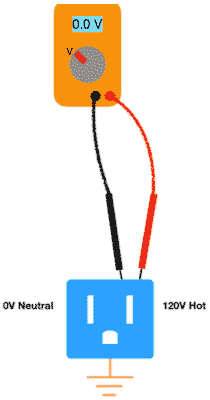
The meter calls the black lead zero, regardless of where it is put. The red is the difference compared to the black lead. If we put the black lead into a grounding plug of an outlet, that would be zero, and the red lead attaches the area of focus (like a hand probe).
Now let’s imagine for a moment that we’re testing a grounding mat since these items are so handy and can solve some of our ‘electric field’ problems, if used correctly.
Many companies that sell these items demonstrate the effectiveness of their product by testing the item with a multimeter.
They will plug the black lead into the grounding plug of an outlet, the same outlet where the grounding mat is plugged in.
(Note this means these items are at the same point– which is the incorrect way to set this up, as we see in figure 1).
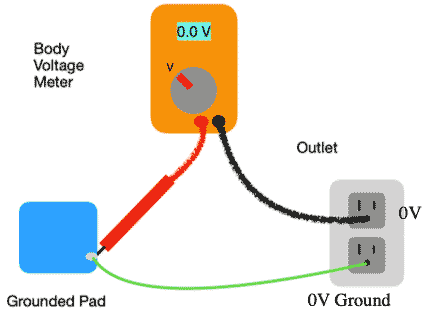
Then they’ll touch the red lead to the grounding mat, and viola, you get a reading of 0 volts! That’s great right? Zero volts means zero current potential.
But wait, these leads are touching the same points- they’re both connected to the same ground point, thus, there is no difference between them, thus, the reading of 0 volts.
And even if we did set up the test correctly ie, testing between two different contact points, we still don’t know the impedance of the skin, its blocking ability under certain condition (wet/frequencies, etc.).
A recommended set up to consider is between an object and the body, like hand (black lead) to mat (red lead). I realize this is backwards but I’d rather consider the body as the zero and check how much is on the mat or other object before I consider touching it.
That will show the pressure difference between the body and the mat (power grid) and that ‘potential’ exchange. Current flows from a higher potential to a lower potential (voltage).
Is the highest point the person by being energized by the room’s high electric fields, or is it the grounded object coming from the grid? It gets complex, too complex. We just need to measure the current and be done with it.
When you measure body voltage, you are not accounting for the role that your skin plays in impeding the flow of electricity– body voltage doesn’t tell us how many electrons will actually penetrate the body.
Though, it is good to use a voltage measurement if you think there is a huge electrical problem. Use voltage as a safe-distance type of measurement to make sure you don’t allow dangerous amounts of current through you!
Measuring Current Instead of Body Voltage
We are looking for incredibly small amounts of current, in the 1 uA range. Since we’re talking about grounding mats, it’s important to note that the act of grounding the body increases contact surfaces and paths, and can therefore increase current flow as you plugged into a circuit.
The more contact points, the more current paths and the lower the total body impedance.
Thus, when you plug your grounding mat into your grounded outlet, and you step on that mat, you have now made contact with the grid’s return current flow path. In other words, you have exposed yourself to contact current.
And as we’ve already noted, it’s the current that creates the health problems. Current does the actual damage.
So, now you can see why testing the body voltage will not what will give us the best information as far as a health standard, or damage assessment. We need to test the actual current. So how do you do this?
According to McAfee: the fastest, most accurate way to know how much current makes it past the skin and through the body is by using a device with resolution at least down to 0.1 μA, and the Fluke 287 or 289 has it down to 0.01 uA.
It’s not too difficult to learn how to use the Fluke, and those interested could definitely do this. The meter is rather expensive though, and not something most home-owners would typically use.
For the gung-ho, I would encourage you to do give it a try, but if forking out $600 on this meter isn’t your speed, then hiring a qualified EMF expert is the way to go.
Note that not all EMF consultants use this meter, it’s a rather advanced tool and mostly appropriate for the very EHS client. But it is essential to know how much current you are being exposed to especially in very low levels.
Set up the Fluke meter between your hand and the object you want to touch. Red lead in hand and black lead on object. That’s it.
Stay tuned, there are videos and PDFs available showing how to set up the the Fluke 287 and see it in action and an official contact current protocol is being designed. See “How Do I Know the NCB is Working.”
As awareness continues to grow surrounding the importance of current, instead of voltage, you will see more and more experts institute current testing as a standard measurement.
Until then, I strongly advise using caution with grounding mats, sheets, and similar devices. If you don’t know the measurement of current they are exposing you to, they could actually be making you ill.
Solutions to Reduce Exposure
If the levels of voltage or current are higher than desirable or healthy, you will want to work to reduce those. Here are some ways to get started.
Test
In this post, I’ve explained various measurements of electrical forces. Electric fields, body voltage, and contact current. Which means that you will want to have these levels test.
Hiring a Building Biologist to do an in-person assessment on your home is the gold standard. However, not everyone lives near a certified Building Biologist.
Which is exactly why we have EMF Home Testing Consulting.
You can also consult with me right here through the SYB Consulting Services. If you find yourself feeling confused or overwhelmed on this topic, just book a virtual consult with me and I will walk you through it.
Start in the Bedroom
It’s critical that your exposure in your bedroom be as low as possible so that you can optimize your sleeping environment. This is where we spend so much time– and it’s time that our bodies should be resting, recuperating, healing and regenerating for the next day.
Start by turning off anything electric in the bedroom. See if the reading changes and record your findings. If the reading is still not low enough, begin to unplug any items in the vicinity. Again, record your findings.
If you still have elevated fields (and you most likely will), then have your assistant turn off the breaker to the bedroom. Often this will drop the reading significantly.
If the readings are still higher than you want, then continue to turn off breakers one by one until you get adequate results.
It is not uncommon that you may need to turn off multiple circuits. Often there are adjoining circuits under the bedroom that will increase the E-fields.
For example, my bedroom is above the kitchen which has lights in the ceiling. This means there are wires that flow through the floor of my bedroom. In order to get my body voltage to less than 10 mV, I need to turn off the breaker to the bedroom, the kitchen, and the hallway.
Once you find the appropriate combination for you, then I suggest installing a remote cutoff switch. These hardwired cutoff switches allow you to turn off the offending breakers with the push of a button from anywhere inside the house. Very convenient!
If you’re in a more complicated situation, like in an apartment building or dorm, turning on and off the breakers may not be an option. In that case, you may want to experiment with shielding paint, foils, fabrics, or even an SYB Faraday Bed Canopy.

In the meantime, don’t forget to go through this same protocol in your office or wherever you spend a lot of time. Your office can also have elevated fields due to all the wires and electrical equipment.
Obviously you can’t turn off the breakers to an office, but there are other shielding techniques you can use. There is conductive tape you can wrap your cords in, conductive tubing, fabrics, and foils that may help to block some of the E-fields.
You may or may not need to ground them. Sometimes grounding increases the fields, sometimes it decreases it You want your appliances electrically grounded and shielded but not your body to that same circuit.
Again, every situation is different, and if you have any questions, you can book time with me and get them answered.
Reducing Ground Current
We are exposed to ground currentDefinition and Basic Concept Ground current refers to electrical currents that flow through the ground or the earth. These currents can be natural, such as those caused by geomagnetic phenomena,... whenever we touch a grounded product with these currents running through them.
This includes grounding products like grounding mats and earthing bed sheets, as well as grounded EMF protection products such as canopies or shielding paint.
In order to eliminate your exposure to grid current when grounding your body with these types of products, you will want to utilize the NCB from SYB.
In order to address the electrical hazards from grounding, we want to stop current on the grounding conductors.
Using the example in this diagram, we have a grounded bed sheet, and a grounding mat.
The NCB is placed between those grounding products and the wall outlet grounding conductor. There’s a resistor in there, and it stops the current from getting to your grounding mat. And you can adjust the resistance with a dial.
And – VITALLY– the NCB maintains an effective “ground-fault path.” You may not know what that means, but it’s really important.
Because, if for some horrible reason an electrical cord is cut or something else goes wrong, and your grounding mat gets electrified, the NCB activates and sends that current back to trip the breaker immediately– protecting you.
This is the only product available that provides this essential protection.
Keep the focus on the overriding problem, the way the North American grounding system is set up.
The ‘Multigrounded Neutral System’ has the return conductor grounded at every home’s service panel, transformer and to the electric pole’s lightning surge protection as well.
Since the grid’s return current system is grounded, they’re putting current into the earth around your home, on the grounding wires in your home, and on everything that is grounded in our home. This has to change.
Concluding Thoughts
As with many issues related to EMF and health, there is a lot to learn. And a seemingly endless list of mitigation that you should do.
As I always say ‘Do your best, then don’t stress.’
The goal of course, is to always get those numbers as low as possible, no matter what type of meter you’re using. So be sure to measure often and mitigate as needed.
Then don’t stress about it!
